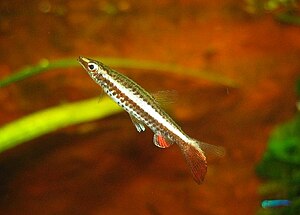Black tetra
| Black tetra | ||||||||||||
|---|---|---|---|---|---|---|---|---|---|---|---|---|

Black tetra ( Nannostomus eques ) |
||||||||||||
| Systematics | ||||||||||||
|
||||||||||||
| Scientific name | ||||||||||||
| Nannostomus eques | ||||||||||||
| Steindachner , 1876 |
The black ornate tetra ( Nannostomus eques ), also known as the sloping tetra, is a freshwater ornamental fish from the slender tetra family .
Occurrence
The black tetra can be found in Guiana, the Rio Negro and the Amazon.
Aquaristics
For around six animals (preferably more females than males), 60 liter aquariums have proven to be sufficient. Larger tanks are preferable, however, as the males as well as the females form territories.
The water values should be acidic and soft - but there have also been reports of offspring in neutral and medium-hard water. The basin should make an overall dark impression, which can be achieved with floating leaf plants such as the South American frog bite (Limnobium stoloniferum). In addition, large and broad-leaved plants such as the spear leaf (Anubias barteri) should be available to lay eggs (one to two plants per male).
Since turf wars can occur from time to time, there should be enough space to allow inferior animals to escape. Black tetras tend only to aggression within the species, so they can be kept well together with other tetras that remain small. Due to the relatively small size of the mouth, only appropriately small food such as Artemia, Cyclops, small mosquito larvae or fine flake or dust food should be given.
features
The body of the black tetra is traversed by three, sometimes four stripes, some of which extend from the tail end to the mouth. The top stripe is light brown to white, the stripe below is a bit lighter. These two strips can also fuse together. The widest stripe that runs through the lower part of the caudal fin and the anal fin is deep brown to black. This is followed by a very thin, white stripe on the underside. The anal fin has one red and two brown to black bands.
Very interesting, as with other tetras, is the night color. This consists of an almost completely brown lower part of the animal and a wide, white line that covers the top of the animal. There are one to three brown to black dots in this white upper line.
Gender differences
Compared to other tetras, the gender differences are easier to recognize: the males appear more strongly colored overall. Their pelvic fins show a bluish-white color at the tips. This is sometimes also found at the lower end of the anal fin, the red longitudinal ligament of which also appears wider and more intense. Sexually willing females can be recognized by their rounder, bulging belly line, while males make a slimmer impression with their straight belly line.
breed
Breeding is possible in the community tank, but if the number of surviving animals is to be maximized, a breeding tank should be set up. A 25-liter tank without a substrate is sufficient in which one male and one to three females are transferred. However, large and broad-leaved plants should also be available. For example, a spear blade can be tied to a root and placed in the basin. The male will soon occupy one of the plants and may clean the undersides of the leaves by removing air bubbles. Then it will go in search of other animals of the same species and attract them to its plant. It does this by going anti-parallel with the female and then fanning her with the tail. If a female is able to get to the plant, she will go under a leaf and turn on her side, releasing an egg. At the same time, the male, who has also turned on its side, releases sperm, which fertilize the egg, which is now attached to the underside of the leaf. This process is repeated up to a hundred times depending on the size of the female and the number of eggs, using different leaves. Right from the start, the young eat newly hatched Artemia and of course powdered food. The temperature should be slightly lower than that of adult black tetras - according to individual reports, excessively high rearing temperatures can lead to stunted growth.
Web links
- Black tetra on Fishbase.org (English)

